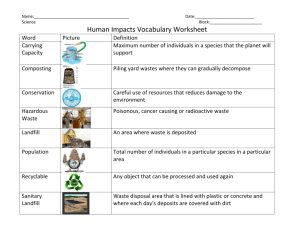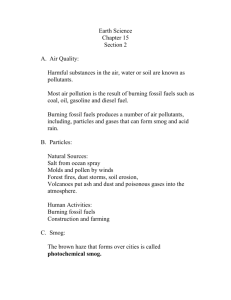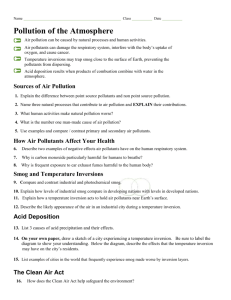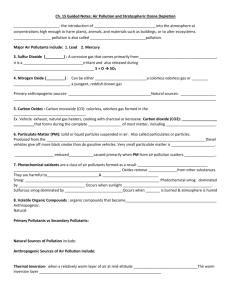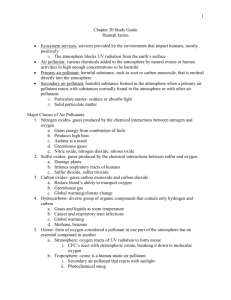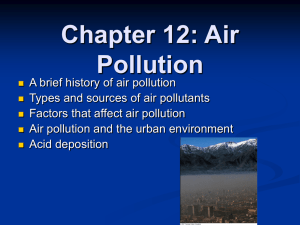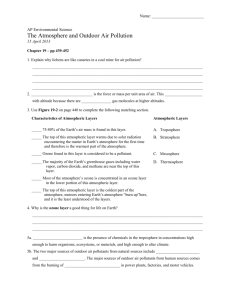Air Pollution
advertisement
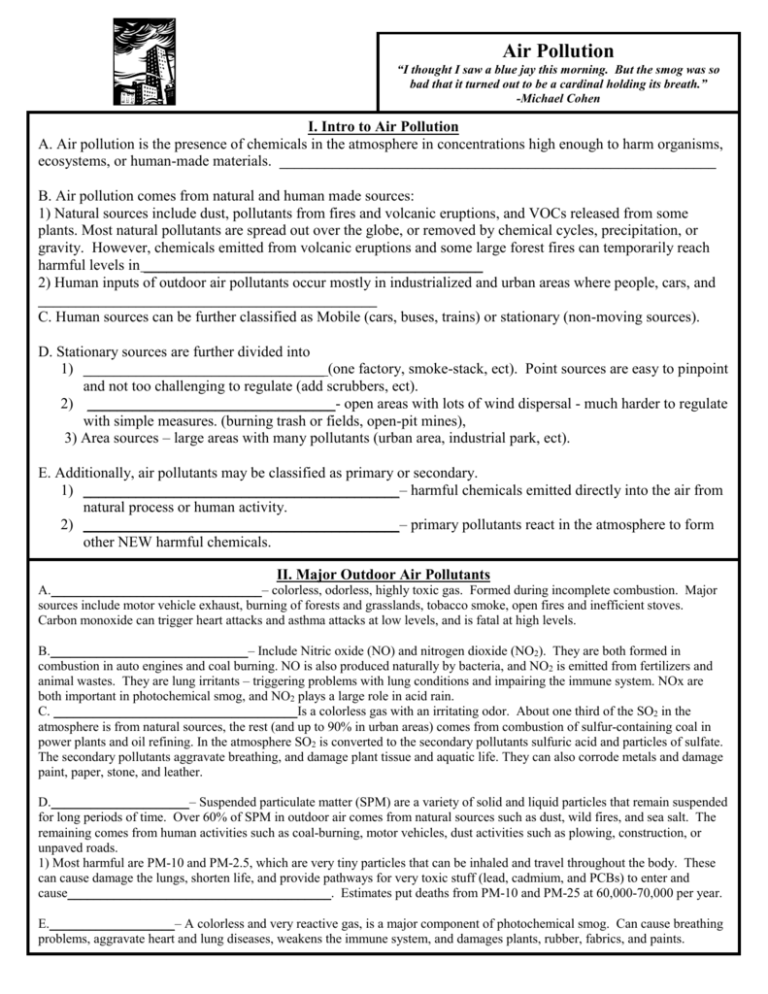
Air Pollution “I thought I saw a blue jay this morning. But the smog was so bad that it turned out to be a cardinal holding its breath.” -Michael Cohen I. Intro to Air Pollution A. Air pollution is the presence of chemicals in the atmosphere in concentrations high enough to harm organisms, ecosystems, or human-made materials. __________________________________________________________ B. Air pollution comes from natural and human made sources: 1) Natural sources include dust, pollutants from fires and volcanic eruptions, and VOCs released from some plants. Most natural pollutants are spread out over the globe, or removed by chemical cycles, precipitation, or gravity. However, chemicals emitted from volcanic eruptions and some large forest fires can temporarily reach harmful levels in _____________________________________________ 2) Human inputs of outdoor air pollutants occur mostly in industrialized and urban areas where people, cars, and _____________________________________________ C. Human sources can be further classified as Mobile (cars, buses, trains) or stationary (non-moving sources). D. Stationary sources are further divided into 1) ________________________________ (one factory, smoke-stack, ect). Point sources are easy to pinpoint and not too challenging to regulate (add scrubbers, ect). 2) _________________________________- open areas with lots of wind dispersal - much harder to regulate with simple measures. (burning trash or fields, open-pit mines), 3) Area sources – large areas with many pollutants (urban area, industrial park, ect). E. Additionally, air pollutants may be classified as primary or secondary. 1) __________________________________________– harmful chemicals emitted directly into the air from natural process or human activity. 2) __________________________________________– primary pollutants react in the atmosphere to form other NEW harmful chemicals. II. Major Outdoor Air Pollutants A.________________________________– colorless, odorless, highly toxic gas. Formed during incomplete combustion. Major sources include motor vehicle exhaust, burning of forests and grasslands, tobacco smoke, open fires and inefficient stoves. Carbon monoxide can trigger heart attacks and asthma attacks at low levels, and is fatal at high levels. B.______________________________– Include Nitric oxide (NO) and nitrogen dioxide (NO2). They are both formed in combustion in auto engines and coal burning. NO is also produced naturally by bacteria, and NO2 is emitted from fertilizers and animal wastes. They are lung irritants – triggering problems with lung conditions and impairing the immune system. NOx are both important in photochemical smog, and NO2 plays a large role in acid rain. C. _____________________________________Is a colorless gas with an irritating odor. About one third of the SO2 in the atmosphere is from natural sources, the rest (and up to 90% in urban areas) comes from combustion of sulfur-containing coal in power plants and oil refining. In the atmosphere SO2 is converted to the secondary pollutants sulfuric acid and particles of sulfate. The secondary pollutants aggravate breathing, and damage plant tissue and aquatic life. They can also corrode metals and damage paint, paper, stone, and leather. D._____________________– Suspended particulate matter (SPM) are a variety of solid and liquid particles that remain suspended for long periods of time. Over 60% of SPM in outdoor air comes from natural sources such as dust, wild fires, and sea salt. The remaining comes from human activities such as coal-burning, motor vehicles, dust activities such as plowing, construction, or unpaved roads. 1) Most harmful are PM-10 and PM-2.5, which are very tiny particles that can be inhaled and travel throughout the body. These can cause damage the lungs, shorten life, and provide pathways for very toxic stuff (lead, cadmium, and PCBs) to enter and cause________________________________________. Estimates put deaths from PM-10 and PM-25 at 60,000-70,000 per year. E.___________________– A colorless and very reactive gas, is a major component of photochemical smog. Can cause breathing problems, aggravate heart and lung diseases, weakens the immune system, and damages plants, rubber, fabrics, and paints. III. Factors Responsible for Increasing or Decreasing Outdoor Air Pollution A. Five natural factors help reduce outdoor air pollution. They are: 1) Gravity helps particles heavier than air settle out of the atmosphere and fall to earth 2) ________________________________________________________________________ 3) Salty sea air and spray from oceans wash out water-soluble pollutants that travel over the ocean 4) _________________________________________________ 5) Some pollutants are removed from the atmosphere by chemical reactions – SO2 reacts with oxygen to form SO3, which reacts with water to form H2SO4, which falls to the earth as acid rain. B. Six other factors increase outdoor air pollution: 1) Urban buildings slow winds, and reduce dilution and removal of pollutants. 2) Hills and mountains slow the flow of air to valleys and allow pollution to build up in them (LA is a valley – LA has smog problems) 3) ________________________________________________________________________. 4) Emissions of VOCs from certain tree and plant species in wooded urban and suburban areas can play a large role in the formation of photochemical smog. (sweet gums, poplar, some oak species, and kudzu) 5) ____________________________________– volatile air pollutants carried by winds travel to the arctic, where they are deposited – pilots for decades have reported reddish-brown haze over the poles. 6) _____________________________________– Cause pollutants to build to high levels over urban areas. A layer of cool air trapped between two layers of warmer air keeps pollutants trapped near ground level. IV. Smog A. Two types of smog –________________________________________________________ B. Industrial smog – formed primarily from burning coal – caused primarily from sulfur dioxide gas and the resulting formation of sulfuric acid. Ammonia in the atmosphere also reacts with the sulfuric acid to produce ammonium sulfate – these particles and soot give the smog a gray color. (so called “grey smog”) C. Industrial smog used to be a huge problem, but today is rarely a problem in developed nations with tighter pollution controls on coal power plants, and where ________________________________________________________ D. However, industrial smog is still a problem in urban areas of China, India, the Ukraine, and Eastern Europe – pollution controls are inadequate or non-existent, and many homes still burn coal. E. ___________________________________________________ F. Photochemical smog is a mixture of primary and secondary pollutants formed by the influence of UV light from the sun. G. Photochemical smog begins with nitrogen present in fossil fuels being burned by the internal combustion engine and producing nitric oxide (NO) and some Volatile Organic Compounds (VOCs). H. NO is converted into reddish-brown NO2, which is why photochemical smog is sometimes called brown-air smog. I. The NO2 then reacts with some of the VOCs in the atmosphere released by vehicles, trees, _____________________________ J. Sunlight and water vapor from the atmosphere create a dense mixture of toxic chemicals, including ozone, photochemical oxidants, aldehydes, Peroxyacyl nitrates (PANs) and other secondary pollutants. K. Together, these chemicals are called __________________________________________because the chemicals react with and oxidize certain compounds in the atmosphere and your lungs. L. Hotter days lead to higher levels of ozone and other components of smog. Usually photochemical smog builds to peak levels in late mornings as the atmosphere heats up and pollutants have been released by morning commuters. High smog (and therefore ozone) levels can irritate the eyes and lungs, and ____________________________________________ M. _________________________________________, but it is much more common in cities with sunny, warm, and dry climates and lots of motor vehicles. N. Examples include L.A., Denver, Salt Lake City, Sydney Australia, Buenos Aires, Argentina, Bangkok, Thailand, and Mexico City. V Acid Deposition (aka Acid Rain) A. Acidic deposition = the deposition of acid, or acid-forming pollutants, from the atmosphere onto Earth’s surface 1. Acid rain = _____________________________________________________________ 2. Atmospheric deposition = the wet or dry deposition on land of pollutants 3. Acid rain is considered to be precipitation with a pH of less than 5.6 B. Acid rain was first observed in England – in the 1800s, homes converted from wood to coal for their heating requirements. Scientists noticed the pH of the precipitation was becoming more and more acidic. Scientists made the connection between increasing acidity and _________________________________________________ C. Sources of Acid Deposition - Originates from burning fossil fuels that release sulfur dioxide and nitrogen oxides (primarily SO2) - These compounds react with water to form sulfuric and ____________________________________ D. Sulfur Oxides (SOx)– Come from both natural and man-made sources (aka nature can make acid rain too!) 1. The primary natural sources for sulfur dioxide are ________________________________________________ 2. The primary man-made sources for sulfur dioxide are burning ______________________________________ _________________________________________________________________________________________ E. Sulfur is a contaminant in fossil fuels, and when burned form sulfur dioxide. Contaminants in the atmosphere (hydroxyl radicals, hydrogen peroxide, and ozone) further oxidize SO2 to form sulfuric acid (H2SO4). F. Primary sources for nitrogen oxides (NOx) are 1) Manmade - ______________________________________ 2) Natural sources – ______________________________________ G. Oxygen and nitrogen combine to form nitric oxide (NO) which further reacts with oxygen in the atmosphere to form nitrogen dioxide (NO2). Nitrogen dioxide reacts with hydroxyl radicals and ozone to form nitric acid. H. Effects of acid deposition 1. Nutrients are leached from topsoil 2. Soil chemistry is changed 3. Metal ions (aluminum, zinc, etc.) are converted into soluble forms that pollute water 4. ________________________________________________ 5. Affects surface water and kills fish 6. Damages agricultural crops 7. Erodes stone buildings, corrodes cars, erases writing on tombstones I. How is plant growth disrupted? 1) Vital nutrients that plants need (K, Ca, Mg) react with acid rain and are removed from the soil and transported away or become chemically unavailable. 2) Acid rain also dissolves and releases toxic metals in the soil (Mn, Hg, Pb, Zn, Al) and these elements, in high enough concentrations, will disrupt plant growth. 3) As plants come in direct contact with acid rain, surface areas of leaves and stems are ______________________________________________________________________________ 4) Plant germination and reproduction are also disrupted by the effects of acid rain. J. Acid deposition has not been greatly reduced 1. New technologies such as scrubbers have helped 2. _______________________________________________________ 3. But, NOx emissions are higher 4. Acid deposition’s effects are worse than predicted - The Clean Air Act cannot restore ecosystems - More must be done to control acid deposition
